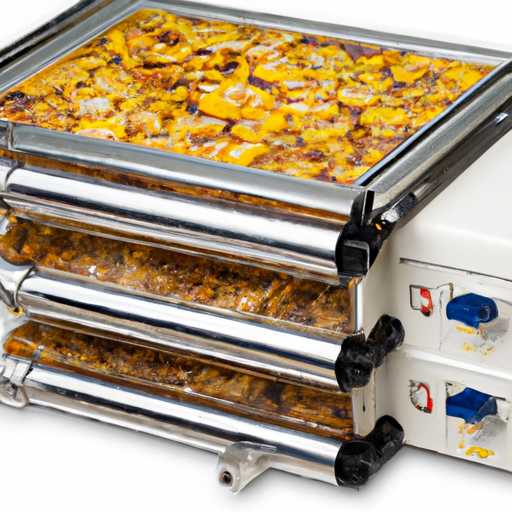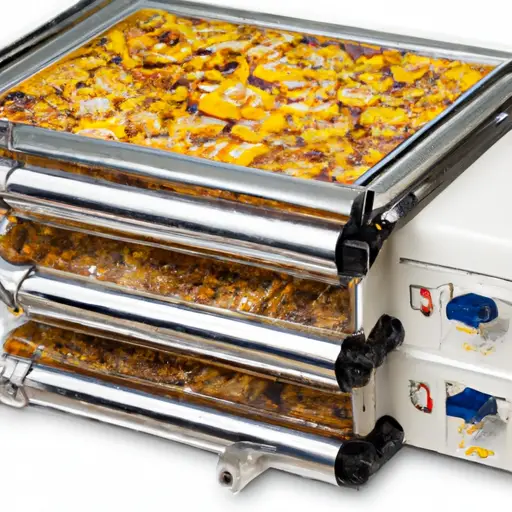Have you ever wondered how people in the past preserved their food without the modern technology we have today? It’s fascinating to think about the innovative techniques they used to make their food last longer. But with all the advancements in technology, I can’t help but wonder which one is the most advanced food preservation technique in our current time. Well, in this article, we’re going to explore the cutting-edge techniques in food preservation, and you’ll be amazed by what you learn.
Food preservation has come a long way from simply drying or salting food. Nowadays, we have techniques that not only extend the shelf life of our favorite foods but also maintain their nutritional value and delicious taste. From vacuum sealing to high-pressure processing, there are several innovative methods being used to preserve food. In this article, we’ll delve deeper into each technique, explaining how they work and the benefits they bring. By the end, you’ll have a better understanding of the most advanced food preservation techniques available today.
So, whether you’re curious about how vacuum sealing keeps your food fresh or want to learn more about the benefits of high-pressure processing, this article has got you covered. You’ll discover the science behind these cutting-edge techniques and how they’re revolutionizing the way food is preserved. So, sit back, relax, and get ready to become an expert on the most advanced food preservation techniques out there. Trust me, you won’t want to miss this!

Introduction
In today’s fast-paced world, food preservation techniques play a vital role in ensuring the availability of safe and nutritious food. Over the years, humans have developed various methods to preserve food, allowing us to enjoy a wide range of culinary delights regardless of the season or geographical location. From traditional techniques such as canning and drying to the latest cutting-edge methods like nanotechnology applications and smart packaging solutions, the field of food preservation has evolved significantly. In this article, we will explore the cutting-edge techniques in food preservation, their advancements, challenges, and the future of this crucial process.
Traditional Food Preservation Techniques
Canning
Canning is one of the oldest and most widely used methods of food preservation. It involves packaging food in airtight containers and heating them to destroy any microorganisms that could spoil the food. Through the use of proper canning techniques, vegetables, fruits, and even meats can be preserved for extended periods.
Drying
Drying is another traditional technique used to preserve food by removing its moisture content. By drying food, water-dependent bacteria, mold, and yeast growth are inhibited, thereby extending the shelf life of the food. Dehydrators, ovens, and even the sun can be used to dry different types of food.
Salting
Salting is an age-old preservation method that utilizes the osmotic effect of salt to remove water from the food and create an inhospitable environment for bacterial growth. It is commonly used for preserving fish, meat, and vegetables.
Pickling
Pickling is a preservation method that involves immersing food in a solution containing salt, vinegar, or a combination of both. The acidic environment created by the solution inhibits the growth of bacteria and enhances the flavor of the food. Pickling is commonly used for preserving cucumbers, onions, and other vegetables.
Emerging Food Preservation Techniques
High-Pressure Processing
High-Pressure Processing (HPP) is a non-thermal preservation method that subjects packaged food to high levels of hydrostatic pressure. This process helps in deactivating spoilage-causing microorganisms while maintaining the food’s nutritional value, texture, and taste. HPP is commonly used for juices, guacamole, and deli meats.
Pulsed Electric Field
Pulsed Electric Field (PEF) technology involves applying short, intense bursts of electricity to food products. This method disrupts the cell membranes of microorganisms, ensuring the destruction of bacteria, yeasts, and molds. PEF technology is mainly used for liquid foods like juices, dairy products, and liquid eggs.
Ultrasound
Ultrasound is a novel preservation technique that utilizes high-frequency sound waves to extend the shelf life of food. The sound waves create pressure changes within the food, effectively inactivating microorganisms. Ultrasound technology is beneficial for both liquid and solid foods.
Chemical Preservation
Chemical preservation involves the use of various chemicals, such as food-grade preservatives, to inhibit the growth of microorganisms and extend the shelf life of food. These chemicals can be natural or synthetic and are widely used in the preservation of processed foods, beverages, and snacks.

Advanced Food Preservation Techniques
Modified Atmosphere Packaging
Modified Atmosphere Packaging (MAP) is an advanced technique that modifies and controls the atmosphere surrounding the food to slow down its spoilage. It involves altering the composition of gases, such as oxygen, carbon dioxide, and nitrogen, inside the packaging. MAP is commonly used for fresh produce, meat, and poultry.
Vacuum Sealing
Vacuum sealing is a method that involves removing air from the packaging of food products to create a vacuum-sealed environment. By eliminating oxygen, the growth of aerobic bacteria and fungi is inhibited, significantly prolonging the food’s shelf life. Vacuum sealing is commonly used for meat, fish, and cheese.
Freeze Drying
Freeze drying, also known as lyophilization, is a preservation technique that involves freezing the food and gradually removing the ice crystals through sublimation. This process preserves the food’s natural flavors, textures, and nutrients and allows for long shelf life. Freeze drying is commonly used for fruits, vegetables, and instant coffee.
Innovative Preservation Techniques
Irradiation
Irradiation is an innovative preservation technique that involves exposing food to a controlled amount of ionizing radiation. This process helps in eliminating bacteria, insects, and other pathogens, significantly reducing the risk of foodborne illnesses. Irradiation is mainly used for spices, fruits, and vegetables.
Ohmic Heating
Ohmic heating is a novel preservation technique that involves passing an electric current through food, thus heating it from within. This method ensures uniform and rapid heating, effectively destroying harmful microorganisms while preserving the food’s quality attributes. Ohmic heating is commonly used for liquid food products.
Hurdle Technology
Hurdle technology is an innovative approach that combines multiple preservation techniques to create “hurdles” or barriers that microorganisms find difficult to overcome. By employing a combination of techniques such as heat, high pressure, acidity, and preservatives, hurdle technology provides enhanced microbial control and extended shelf life for a wide range of food products.
Cutting-Edge Techniques in Food Preservation
High-Pressure Processing Combined with Modified Atmosphere Packaging
The combination of High-Pressure Processing with Modified Atmosphere Packaging has revolutionized the field of food preservation. The collaborative use of these two techniques allows for effective microbial control while maintaining the product’s freshness, quality, and taste. The synergy between HPP and MAP has paved the way for the preservation of a wide range of food products, including fruits, vegetables, and dairy.
Pulsed Electric Field Assisted Freeze Drying
The integration of Pulsed Electric Field technology with freeze drying offers enhanced preservation outcomes. PEF helps to disrupt the cell membranes, allowing for efficient water removal during the freeze-drying process. This combination results in improved product quality, reduced drying time, and better retention of the food’s nutritional value.
Revolutionary Strategies in Food Preservation
Nanotechnology Applications
Nanotechnology has recently emerged as a groundbreaking approach in food preservation. Nanoparticles, such as silver and titanium dioxide, can be used to inhibit microbial growth, detect spoilage agents, and improve food packaging materials. The use of nanotechnology in food preservation offers tremendous potential in improving food safety, quality, and shelf life.
Smart Packaging Solutions
Smart packaging, equipped with sensors and indicators, is poised to revolutionize the food preservation industry. These advanced packages can monitor and communicate information about food quality, temperature, and spoilage, providing consumers with real-time data to make informed decisions. Smart packaging helps in reducing food waste and maintaining the food’s freshness and safety throughout its shelf life.
Challenges in Implementing Advanced Techniques
Costs and Accessibility
While advanced food preservation techniques offer numerous benefits, their implementation can be challenging. The equipment required for certain methods, such as HPP, PEF, and nanotechnology, can be costly. Additionally, the accessibility of these techniques may be limited to larger food processing facilities, posing obstacles for small-scale businesses and developing regions.
Safety Concerns
The safety of advanced food preservation techniques is an area of concern for both consumers and regulators. Technologies like irradiation and nanotechnology need to undergo rigorous testing and risk assessment to ensure they do not compromise food safety or pose health risks. Public acceptance and understanding of these techniques also play a crucial role in their successful implementation.
Future of Food Preservation
Technological Advancements
As technology continues to evolve, so does the potential for advancements in food preservation techniques. Continued research and development in areas such as nanotechnology, biotechnology, and robotics will likely lead to even more innovative methods of extending the shelf life of food while maintaining its quality and safety.
Sustainable Preservation Methods
With the growing focus on sustainability, future food preservation methods are expected to prioritize environmental considerations. This includes reducing energy consumption, minimizing waste generation, and using eco-friendly materials. Sustainable preservation methods will not only ensure the availability of safe and nutritious food but also contribute to the overall well-being of our planet.
Conclusion
Food preservation techniques have come a long way, from traditional methods to the cutting-edge and revolutionary strategies we see today. The advancements in technology and the ongoing quest for improving food safety, quality, and availability have paved the way for these innovative preservation techniques. While each method has its merits and limitations, it is the combination of these approaches that holds the key to the future of food preservation. By harnessing the power of technology, addressing challenges, and embracing sustainability, we can ensure a future where safe and nutritious food is readily available to everyone, regardless of geographical or seasonal constraints.




